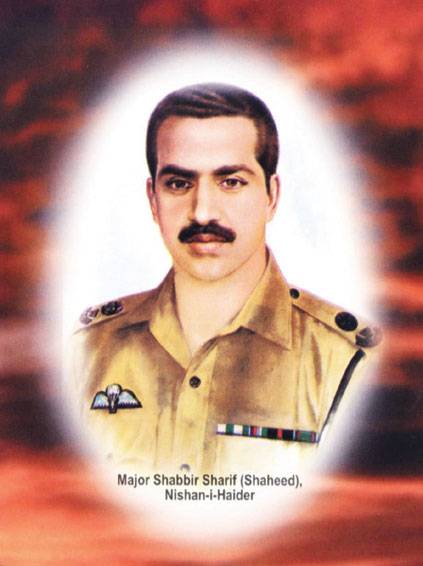LAHORE - The 49th martyrdom anniversary of Major Muhammad Shabbir Sharif Shaheed is being observed on Sunday (today). Major Muhammad Shabbir Sharif Shaheed was born on April 28, 1943 in a Rajput family at Kunjah District Gujrat to Major Rana Muhammad Sharif. His father was also retired from Pakistan Army.
Major Shabbir got his early education from Lahore’s St. Anthony High School. He was intellectually an exceptional student. He had been declared the best sportsman of hockey and cricket in Saint Anthony High School. Major Shabbir Sharif’s younger brother General Raheel Sharif has served as Chief of Army Staff (COAS), the highest rank in Pakistan Army. He is also relative of another holder of NH, Major Raja Aziz Bhatti Shaheed.
While studying at Government College Lahore in 1961, he was selected for Pakistan Army and underwent training with 29 Long Course at PMA, Kakul on 28 April 193. Major Shabbir was an outstanding player of hockey, cricket, football, athletics and cycling. At the PMA, he passed out on top, winning the “Sword of Honour”. Major Shabbir Sharif got commissioned on 19 April 1964 in 6 Frontier Force regiment. Promoted to the rank of Lieutenant on 1st October 1965, Captain on 19 April 1966 and later on was promoted to the rank of Major on 19 April 1970.
In 1965 War, after the commencement and facing tough resistance, 6 Frontier Force operations was slowed down and suffered casualties. The Brigade Commander at that stage ordered 6 Frontier Force to send out a reconnaissance patrol to take a look at the deployment of Indians on and around Troti feature. Shabbir who was originally tasked to carry out reconnaissance saw an opportunity where an artillery battery was in a state of rest and not fully alert. Seeing an opportunity, he changed his mind and instead of going back, he attacked the Gun Positions and got them into a panic, thus forcing them to either withdrawal or surrender.
He captured four Indian Prisoners of War (POWs) and having destroyed two guns, he brought along a field gun towed to a gun-tower (Shaktiman). He put his own wounded soldiers and Indian POWs in the same vehicle. Operations of 10 Infantry Brigade were resumed with 6 Frontier Force again leading on the main axis with 13 Lancers in support and the other action being undertaken by 14 Punjab Regiment, which were to move on the right flank and maneuver, and get around Troti Feature and face towards Jaurian.
These operations were a great success and the Indians panicked and ran. The Brigade took a large number of vehicles, ammunition dumps and POWs. It was perhaps the largest ever haul of men and materials in all our wars with India. Maj Shabbir was awarded Sitara-e-Jurat during the War. In 1971 War, at the outbreak of hostilities, a preemptive operation was launched to capture the Sabuna Bund in order to give greater depth and protection to the Sulaimanki Headworks.
Major Shabbir not only captured that with lightning speed but held his position against all odds. During the war, a company commander from India, Major Narain Singh, had sworn before going on attack that he either would retake the bridge, or would never return.
Narain Singh was also interested in defeating Shabbir Sharif, as for the last two days he had been hearing from his own men that the Pakistani side had a very tough commander with them. While the battle was going on, Narain Singh, with a few men, came very close to Shabbir‘s position. Where is Shabbir Sharif? He called out, if he has the courage, he should come out right now and face me like a man.
Shabbir Sharif, being as hot-headed as was the Singh, left his position and jumped in front of him upon the call. Perhaps, Narain Singh could not make out that it was Shabbir Sharif, as it was very dark, and he lobbed a grenade in his direction.
The grenade exploded a few feet away from Shabbir and his shirt caught fire. A hand-to-hand combat followed between Sharif and Singh. After a short struggle, Shabbir managed to throw Singh on the ground and put his knee on his chest. Taking the Sten gun from his hand, he emptied it on Singh‘s chest. While the Pakistani soldiers came to Sharif to check whether he was alright, those accompanying Singh disappeared in the darkness.
The ferocious non-stop battle of December 4, 5 and 6 was an amazing feat of valor and sacrifice led by the Company Commander, Major Shabbir.
At around 1100 hours on December 6, the Indians launched yet another major counter-attack with tanks, preceded by an air strike and heavy artillery fire. Major Shabbir started firing on the Indian tanks with 106 mm RR. While he was engaged in targeting the enemy tanks, one of the enemy tanks fired with its main gun at him, which proved fatal. Major Shabbir gave his life leading from the front and fighting until the last minute.
Here was a brave man whose mere presence was a guarantee of victory. He had said this before the war, if war breaks out this time, I will not be a witness to ceasefire.
It is worth mentioning that this operation by 6 Frontier Force was so humiliating for the Indians that in 12 days, they changed their General Officer Commanding, and Brigade Commanders thrice in this Sector. He was decorated with Nishan-i-Haider for his bravery and deeds of valour.






